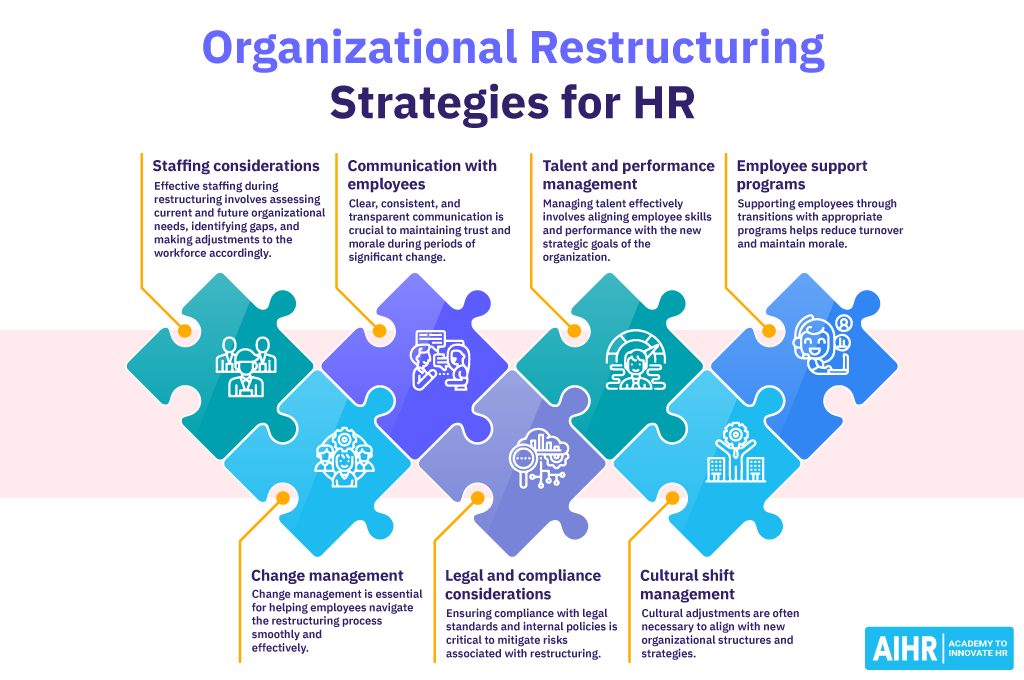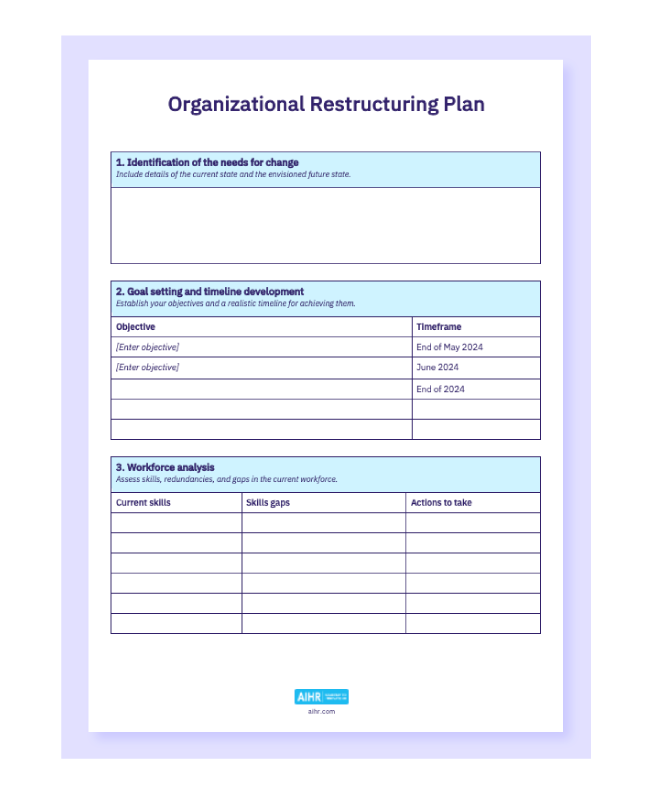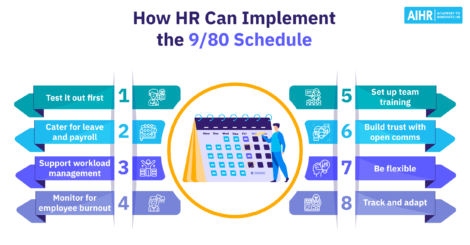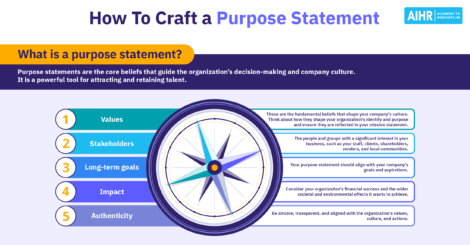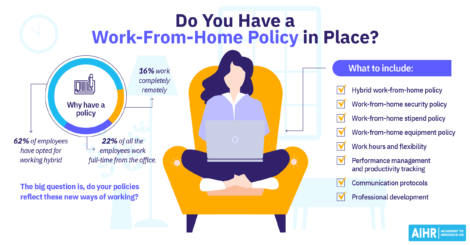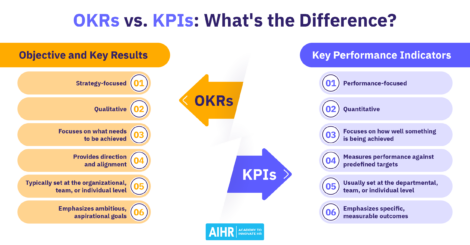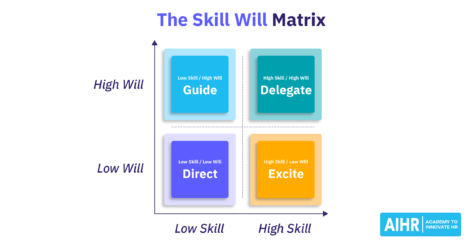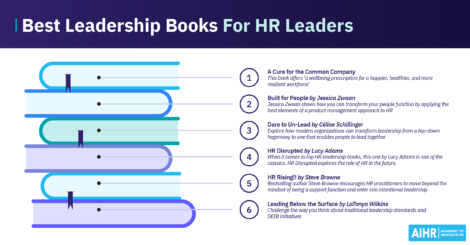Organizational Restructuring: 7 Strategies for HR (Plus Free Template)
Restructuring helps firms innovate, capitalize on new opportunities, and maintain industry relevance.

Higher interest rates and economic uncertainty fueled a surge in organizational restructuring in recent years and have set the stage for another potential increase. 2023 saw a 68% jump in bankruptcies compared to the previous year.
Many companies are closely monitoring potential economic improvements, including rate cuts and favorable geopolitical shifts, as they are impacted by tightened margins. Corporate restructuring will likely remain on the agenda as companies seek to swiftly adapt to changing market conditions, enhance operational efficiency, and ensure long-term financial sustainability.
Contents
What is organizational restructuring?
The role of HR in organizational restructuring
Types of organizational restructuring
7 organizational restructuring strategies for HR
Organizational restructuring examples
Organizational restructuring plan template
Organizational restructuring announcement letter
9 steps HR should take in organizational restructuring
What is organizational restructuring?
Organizational restructuring is a strategic process aimed at enhancing efficiency, adapting to new market demands, or improving competitiveness. It can significantly alter a company’s structure, strategy, and operations.
The process includes realigning departments, redefining roles and responsibilities, and sometimes downsizing to improve efficiency and effectiveness. It’s not just a cost-cutting measure but a strategic decision to improve overall productivity and long-term sustainability.
Organizations may decide to restructure for various reasons:
- Responding to economic pressures: Economic downturns or shifts in market conditions can necessitate changes in how a company operates to maintain its competitiveness.
- Mergers or acquisitions: Combining different cultures, systems, and processes from multiple organizations can require thoughtful restructuring to achieve seamless integration.
- Continuous improvement initiatives: Ongoing efforts to enhance processes and reduce inefficiencies often call for periodic restructuring to align with best practices and technological advancements.
- Leadership changes: New leaders may bring different strategic visions that necessitate changes in organizational structure to support new directions and initiatives.
The role of HR in organizational restructuring
HR plays an important role in reshaping the organizational model to align with new business strategies and objectives. HR is involved in managing the operational aspects of restructuring and supporting the organization’s strategic vision.
Here are HR’s key responsibilities and roles during corporate restructuring:
- Overseeing staff reduction processes: HR is responsible for planning and executing staff reductions in a manner that is legally compliant and handled ethically. This includes determining severance packages, conducting exit interviews, and ensuring that the process is transparent and respectful to affected employees.
- Managing communication strategies: Effective communication is vital during restructuring. HR must develop a communication strategy that keeps all stakeholders informed throughout the process. This involves regular updates about the restructuring plans, timelines, and potential impact on employees. Clear and consistent communication helps manage the uncertainty and anxiety typically associated with organizational changes.
- Redeployment and retraining of employees: As part of restructuring, HR may need to redeploy employees to different roles that better suit the new organizational structure. This often requires retraining employees to equip them with the necessary skills for their new roles. HR must assess the skills gaps and implement training programs to ensure a smooth transition.
- Facilitating post-restructuring culture shifts: After restructuring, there is often a need for a shift in organizational culture to align with the new business direction. HR plays a crucial role in driving this cultural change, fostering a culture that supports the organization’s strategic goals. This includes reinforcing new values, behaviors, and ways of working that support the revamped organizational model.
- Monitoring employee morale and engagement: Throughout the restructuring process, HR needs to monitor and address changes in employee morale and engagement. This includes conducting employee engagement surveys, setting up feedback mechanisms, and implementing initiatives to maintain or improve employee engagement during the transitional period.
- Strategic workforce planning: HR must align the workforce plan with the future needs of the business. This involves analyzing current workforce capabilities, forecasting future needs, and developing a plan to close the gap between the current state and future requirements. This strategic planning is crucial for ensuring that the organization has the right talent in place to achieve its objectives post-restructuring.
HR tip
During times of change, maintaining or increasing employee engagement is essential. Engage employees through involvement in decision-making where appropriate, recognize and celebrate milestones and successes, and provide clear pathways for feedback. This not only helps retain talent but also smooths the transition by making employees feel valued and involved in the process.
Types of organizational restructuring
Legal restructuring
This involves changing the company’s legal structure to meet regulatory requirements, optimize tax strategies, or better align with business strategies. Legal restructuring may include forming, merging, or dissolving company entities.
Functional restructuring
This targets the functions within an organization, such as sales, marketing, or production. The aim is to enhance efficiency by reallocating resources, merging similar functions, or even outsourcing certain functional tasks.
Strategic restructuring
Strategic restructuring involves rethinking and realigning the company’s strategic goals to adapt to market changes, technological advancements, or changes in consumer behavior. It may require pivoting to new markets, products, or service offerings.
Cost restructuring
Here, the focus is on reducing expenses to improve financial health. Techniques can include streamlining operations, reducing the workforce, renegotiating contracts, and cutting non-essential costs.
Divestment
This type of restructuring involves selling off parts of the organization to raise capital, exit non-core businesses, or simplify the organizational structure. Divestments help the company to focus on its core competencies.
Mergers and acquisitions (M&A)
M&A involves either merging with or acquiring another company to enhance competitive positioning, enter new markets, or gain new technologies. This can radically transform the company’s operations, market presence, and strategic direction.
Portfolio restructuring
This is about reviewing and adjusting the mix of businesses or investments a company holds. The aim is to optimize the investment portfolio’s performance in line with the company’s strategic objectives.
Cultural restructuring
Although less tangible, cultural restructuring is crucial and involves changing the corporate culture to support new organizational directions or structures. This might be necessary after mergers, during leadership changes, or when trying to innovate corporate practices.
Each type of restructuring is based on specific internal needs and external conditions, and often, multiple types are implemented concurrently to achieve comprehensive transformation.
7 organizational restructuring strategies for HR
Here are seven strategic frameworks and actions HR needs to implement:
1. Staffing considerations
Strategic framework: Effective staffing during restructuring involves assessing current and future organizational needs, identifying gaps, and making adjustments to the workforce accordingly.
Actions for HR:
- Conduct a thorough workforce analysis to understand the skills and positions required for future success
- Review and update organizational charts and job descriptions to reflect new roles and responsibilities
- Develop a redeployment strategy for current employees to fill new or altered positions, which may include training programs to upskill employees
- Coordinate with HR partners to evaluate the impact of staffing changes on procedural requirements, implementation costs, and necessary communications.
2. Change management
Strategic framework: Change management is essential for helping employees navigate the restructuring process smoothly and effectively.
Actions for HR:
- Engage in proactive planning to anticipate challenges and responses throughout the restructuring process
- Establish a change management team dedicated to implementing and monitoring change efforts
- Facilitate open dialogue and transparency to address employee concerns and gather feedback
- Develop and execute a comprehensive training program to aid employees in adjusting to new roles and processes.
3. Communication with employees
Strategic framework: Clear, consistent, and transparent communication is crucial to maintaining trust and morale during periods of significant change.
Actions for HR:
- Regularly communicate updates about the restructuring process, decisions, and impacts to all employees
- Use multiple channels to communicate changes to ensure the message reaches everyone effectively
- Provide a platform for employees to ask questions and express concerns, such as Q&A sessions or dedicated email addresses.
4. Legal and compliance considerations
Strategic framework: Ensuring compliance with legal standards and internal policies is critical to mitigate risks associated with restructuring.
Actions for HR:
- Review changes in employment status, such as FLSA overtime eligibility and compliance with the WARN Act, where applicable
- Consult legal experts to understand the implications of layoffs, changes in contract terms, and collective bargaining agreements
- Implement risk management strategies to address potential legal challenges.
5. Talent and performance management
Strategic framework: Managing talent effectively involves aligning employee skills and performance with the new strategic goals of the organization.
Actions for HR:
- Redefine performance metrics to reflect new organizational goals and job responsibilities
- Foster a performance management culture that encourages continuous improvement and aligns with strategic objectives
- Identify high-potential employees and ensure they are placed in roles where they can have the most impact.
6. Cultural shift management
Strategic framework: Cultural adjustments are often necessary to align with new organizational structures and strategies.
Actions for HR:
- Promote values and behaviors that support the new organizational direction
- Facilitate workshops and training sessions to help embed these new cultural elements
- Recognize and reward behaviors that reinforce the desired organizational culture.
7. Employee support programs
Strategic framework: Supporting employees through transitions with appropriate programs helps reduce turnover and maintain morale.
Actions for HR:
- Offer counseling and support services to help employees cope with changes
- Provide career development programs to assist employees in adapting to new roles or careers
- Implement flexible work arrangements to help employees balance work and personal commitments during transitional periods.
Organizational restructuring examples
Example 1. The Wall Street Journal
The WSJ, a flagship publication of Dow Jones, underwent a significant reorganization in 2017 to shift towards a more digital-focused strategy.
From an HR standpoint, this restructuring was handled with a strong emphasis on minimizing layoffs. Instead of reducing its workforce, WSJ reallocated existing employees to new roles suitable for a digital environment.
This strategy involved asking employees to apply for newly defined positions, allowing the company to maintain a stable headcount while aligning its workforce with technological advancements and market needs.
This approach helped in retaining talent and ensured that the existing employees were part of the transition, supporting a smoother cultural shift towards digital operations.
Example 2. Hulu
Hulu’s reorganization in 2023 was driven by its need to support rapid growth and expand its streaming content.
The restructuring led to the creation of new key management positions, including a Chief Technology Officer and Chief Data Officer, to align with its strategic priorities.
Hulu’s HR approach focused on both scaling up by hiring new tech and product employees and streamlining operations to enhance efficiency. This dual focus helped Hulu manage its existing workforce effectively during the transition and attract new talent to support its expansion plans.
The restructuring was part of a broader strategy to make Hulu more attractive to potential buyers and investors, particularly during a time when it was considered a valuable asset in Disney’s bid to purchase 21st Century Fox.
HR tip
Keep all employees informed throughout the restructuring process. Transparent communication prevents rumors, reduces anxiety, and builds trust. Ensure that messages are clear and consistent, detailing what changes are occurring, why they are needed, and how they will impact the various team members.
Organizational restructuring plan template
Organizational restructuring announcement letter template
The announcement letter is critical in the early stages of organizational restructuring. It will set the tone and expectations for the changes ahead.
Dear [Employee Name],
We are writing to inform you that [Company Name] will undergo a significant organizational restructuring that will [briefly state the goals and the extent of the restructuring]. We understand that change can be unsettling, but this strategic initiative is vital for the continued success of our company
In the coming days and weeks, HR will provide more information about how these changes will affect you and your role within the organization. We are committed to open communication and supporting all employees through this transition.
We appreciate your dedication and look forward to working together as we transition into this new [Company Name] phase.
Sincerely,
[HR Representative or Leadership Team]
9 HR steps HR to take in organizational restructuring
These are nine steps HR can take in organizational restructuring:
- Step 1: Conduct a workforce analysis: Begin by assessing the current workforce capabilities, identifying skills gaps, and forecasting future needs. This helps determine which roles need to be filled, retained, or redefined to align with the new organizational goals.
- Step 2: Develop a redeployment strategy: Plan for moving employees to new roles or departments where their skills are most needed. Consider the potential for internal mobility and career progression, which can help retain talent and maintain morale.
- Step 3: Implement a retraining program: Provide training and development opportunities to help employees adapt to new roles. This includes upskilling and reskilling programs tailored to the organization’s strategic directions and the workforce’s specific needs.
- Step 4: Support leadership development: Equip leaders with the necessary skills and knowledge to guide their teams through the transition. This involves training leaders on change management, communication, and leadership in a changing environment to ensure they can effectively support their teams.
- Step 5: Manage outplacement services: For eliminated positions, provide support such as counseling, resume workshops, and job search assistance. This shows a commitment to the welfare of outgoing employees, preserving the company’s reputation, and supporting community employment.
- Step 6: Monitor employee wellbeing: Implement initiatives that support employee mental health and morale during the transition. This could include wellness programs, open forums for feedback, and regular communication to keep the workforce engaged and informed.
- Step 7: Evaluate the restructuring impact: Regularly review the outcomes of the restructuring against the initial objectives. This ongoing evaluation helps HR adjust strategies as needed, ensuring the restructuring achieves its goals without adversely impacting the organization or its people.
- Step 8: Facilitate continuous communication: Throughout the restructuring process, maintain clear and open lines of communication. Inform employees about the reasons for the changes, the expected outcomes, and how they will be affected. Transparency is key to maintaining trust and commitment during periods of change.
- Step 9: Strengthen organizational culture: Post-restructuring, focus on reinforcing a positive organizational culture that aligns with the new business model. This involves promoting values that support the new strategic direction and encouraging behaviors that foster innovation and collaboration.
To sum up
Companies undertake corporate restructuring to improve efficiency, adapt to new market conditions, or achieve specific business objectives. Changing the organizational structure may include altering reporting relationships, redistributing responsibilities, and consolidating or dividing departments. The goal is to optimize workflow, enhance communication, and better align resources with the company’s strategic goals. These changes often lead to shifts in job roles, the introduction of new technologies, or modifying operational practices.
For HR, organizational restructuring presents challenges and opportunities. HR is pivotal in managing the change process, ensuring smooth transitions while minimizing disruption to operations and employee morale. This involves clear communication about the reasons for changes, the expected outcomes, and the impacts on staff. HR must also handle practical aspects like redefining job descriptions, overseeing training programs for new skills, and possibly managing layoffs or reassignments. Effectively, HR’s role is critical in maintaining stability and cultivating a positive work environment during the upheaval of restructuring.
Weekly update
Stay up-to-date with the latest news, trends, and resources in HR
Learn more
Related articles
Are you ready for the future of HR?
Learn modern and relevant HR skills, online




